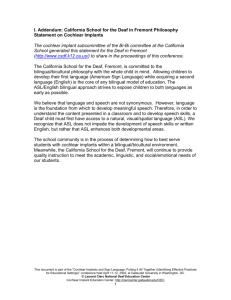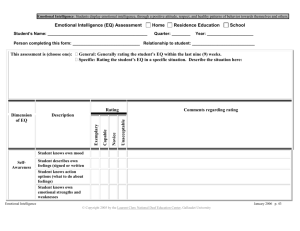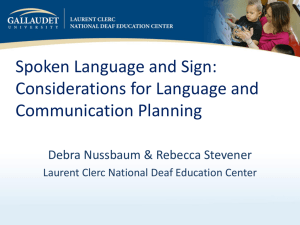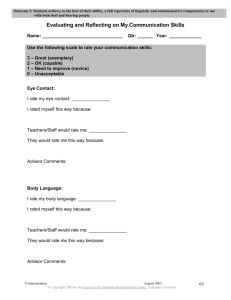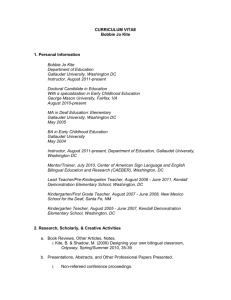An ASL/English Bilingual Parent-Infant Program at the Laurent Clerc
advertisement
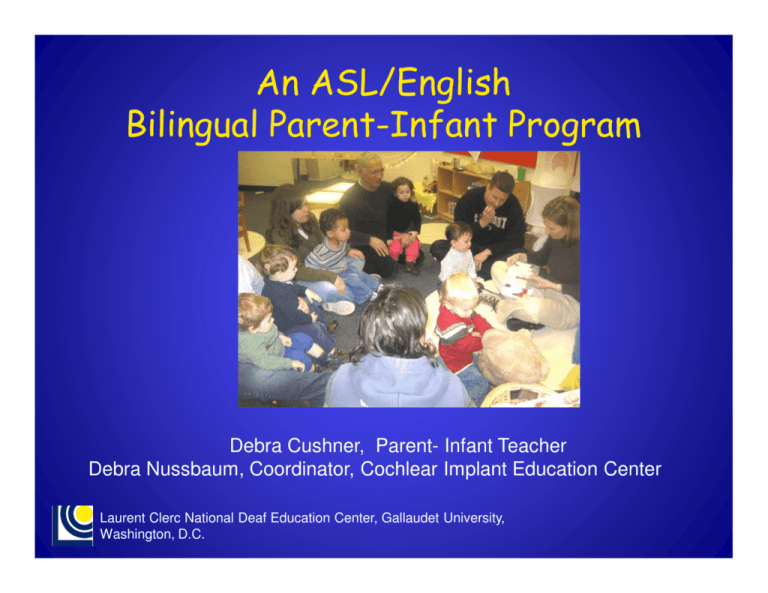
An ASL/English Bilingual Parent-Infant Program Debra Cushner, Parent- Infant Teacher Debra Nussbaum, Coordinator, Cochlear Implant Education Center Laurent Clerc National Deaf Education Center, Gallaudet University, Washington, D.C. Agenda • What does “bilingual” mean? • Why consider an ASL/English bilingual approach? • The KDES ASL/English bilingual PIP program Laurent Clerc National Deaf Education Center, Gallaudet University, Washington, D.C. Defining ASL/English Bilingual Acquisition, learning, and use of American Sign Language and English to meet the needs of diverse students Working definition: Laurent Clerc National Deaf Education Center Laurent Clerc National Deaf Education Center, Gallaudet University, Washington, D.C. Thoughts on ASL/English Bilingual Education • The bilingualism model in the Deaf community, may also be referred to as bimodal bilingualism. • Depending on the child, the two languages will play different roles: some children will be dominant in sign language, others will be dominant in oral language, and some will be balanced in their two languages. • Provision of two languages and two cultures provides the opportunity for “child choice” Grosjean,F (2008). Chapter 13: The Bilingualism and Biculturalism of the Deaf. Studying Bilinguals. New York: Oxford University Press Laurent Clerc National Deaf Education Center, Gallaudet University, Washington, D.C. What the research shows… Brain imaging suggests that the brain can readily handle dual language development (bimodal-bilingual) Petitto, L. A., Katerlos, M., Levy, B., Gauna, K., Tétrault, K. & Ferraro, V, 2001, Kovelman,I, Shalinsky,M.,White, K., Schmitt, S.,Berens, Petitto, L.A. (in press) Laurent Clerc National Deaf Education Center, Gallaudet University, Washington, D.C. Myths ASL/English Bilingual Education • MYTH: American Sign Language is not a “real” language • MYTH: Bilingualism means near perfect mastery of each language • MYTH: “English” does NOT include spoken English • MYTH: ASL is detrimental to a child’s development of English Laurent Clerc National Deaf Education Center, Gallaudet University, Washington, D.C. 6 Why consider a “bilingual” approach ? • It is important for deaf children to have complete access to language as early as possible. • It is through language that children develop social/emotional and cognitive abilities that are critical to timely development in all areas. • We do not know the outcomes of each child related to spoken English for learning…despite improved technology through hearing aids and cochlear implants Laurent Clerc National Deaf Education Center, Gallaudet University, Washington, D.C. Why consider a bilingual approach for children with “auditory access” • Even with early amplification and/or implantation, prime language learning time is lost prior to a child’s potential to “listen to learn” through their listening technologies. • Not all children demonstrate expected spoken language outcomes with their hearing aids and/or cochlear implant(s) even if they have “auditory access”. Laurent Clerc National Deaf Education Center, Gallaudet University, Washington, D.C. Kendall School ASL/English Bilingual PIP Program Laurent Clerc National Deaf Education Center, Gallaudet University, Washington, D.C. Supporting Bilingualism • Deaf and Hearing professionals. (role models in each language, modeling of language separation) • Incorporation of ASL specialists and Speech/Language specialists to facilitate skill development in each language. • Assessment in each language • In-house audiology services • Individualized language planning via the IFSP. • Language use in the classroom modified based on activity, person, place, and individualized student goals. Laurent Clerc National Deaf Education Center, Gallaudet University, Washington, D.C. Supporting Bilingualism continued… • Availability of additional supports, – Shared Reading Program – Family Sign Language classes • Professional development in bilingual ASL/English education. • Family education re: ASL/English bilingual education. • Availability of bilingual resources. • Interpreters in the classroom. Laurent Clerc National Deaf Education Center, Gallaudet University, Washington, D.C. Laurent Clerc National Deaf Education Center, Gallaudet University, Washington, D.C. Schedule: Language use 9:30-10:30 Open Exploration » Individualized language use (1-1) » Spoken English service integration 10:30-10:45 Surprise Box » ASL 10:45-11:00 Snack and Announcements » Snack - ASL moving to individualized language use (1-1) » Announcements-ASL 11:00-11:30 Motor activities (outdoor play, gross motor play) » Individualized language use (1-1) » ASL services integrated Storytime » ASL 11:30-11:50 11:50-12:30 Open Exploration » Individualized language use (1-1) Laurent Clerc National Deaf Education Center, Gallaudet University, Washington, D.C. Adult Role Models in ASL Adult Role Models in English ASL Storytime ASL support for families Small group auditory/speech activities Spoken English skill development integrated into the classroom Announcements- Why ASL? Opportunities for Literacy Development Opportunities for Literacy Development continued…. Linking Sign to Print Making links between ASL and spoken English Making links between sign-print-spoken English Visual PhonicsAnother Strategy to Support English Watching each language grow…. English Watching each language grow-ASL For further information Contact: Debra.Cushner@gallaudet.edu or Debra.Nussbaum@gallaudet.edu See our website at: http://clerccenter.gallaudet.edu/


